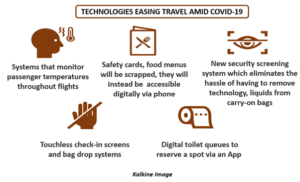Remember the flying cars from The “Jetsons”? Or “Back to the Future Part 2” that took the baton forward and evoked the global fascination with flying cars?
What we are saying is the fact that the future of travel has always captured human imagination. ‘What’s next’ has been an interesting discussion in this industry.
Here is an icebreaker- though we do not have flying cars yet, the future of travel and transport is looking incredibly positive- thanks to technology revamping almost everything, be it a check-in service or lavatory trips midair!
2020 – The Devastating Year for Travel Industry
The travel industry has been a provider of decent jobs, stable incomes, cultural and natural heritage spread. However, the tourism sector was devastated by COVID-19, sailing into a hurricane. So much so, a report by the World Economic Forum suggests that 120 million jobs remain at risk, with economic damage likely to exceed over USD 1 trillion in 2020 alone.
Besides, the World Tourism Organization expects international tourism receipts to drop between USD 910 billion and USD 1.2 trillion in 2020, which would set the global tourism industry back by two decades!
“It is imperative that we rebuild the tourism sector”, says UN Secretary-General Antonio Guterres.
Travel Industry in The New Normal
As an industry, the travel businesses deal with crisis quite frequently, and at the same pace, are known to implement robust risk-based response. The same principle seems to be creeping in as the world gears up to adjust in the “new normal”.
Owing to successful global compliance to virus containment measures, travel seems to be finally picking its lost steam. A McKinsey study reveals that there are notable signs of latent demand for travel. This means that customers are interested in and willing to travel again when allowed, even before a vaccine is available at scale.
To hit the ground running, airports and airlines are installing futuristic technologies to be deployed once travel restrictions are eased. Advanced technology seems to the rescue aimed primarily at reducing public touch points and congregating in queues.
WATCH THIS: Trends Shaping the Australian Travel Industry
Technology to the Rescue!
Airports have been analysing contemporary ways to avert the risk of the coronavirus spreading. Below are a few measures that are being considered-

High-tech safety measures are already being installed at various airports across Australia, be it the Avalon Airport in Melbourne, the Sydney Airport, or the Adelaide airport. Let us cast an eye over a few technological developments that can support safe travel-
- Touchless technologies like digital toilet queues, systems that monitor passengers’ temperatures throughout flights may significantly reduce the risk of the coronavirus spreading.
- Contemporary security screening systems which eliminate the hassle of having to remove technology and liquids from carry-on bags will be a huge help to curtail the virus.
- Touchless check-in screens and bag drop systems are another add-ons to ensure high-tech safety measures.
- A biometric device could scan passengers’ faces for security reasons once they check in.
- Safety cards and food menus undergo multiple human touch. Replacing these digitally via the passenger’s phone seems to be a safe option.
- To book a spot for the lavatory usage, passengers can use an App.
Most interestingly, thanks to the gift of the brain and the will of invention, humans can come up with more such applications of technology which will change one’s flying experience in the near future.
Australians Gear Up to Get on a Plane!
Though a bit against the grain, travel does seem to be turning the corner. Coronavirus restrictions have begun to ease in Melbourne owing to controlled cases.
Spewing optimism, Victorian Premier Daniel Andrews recently announced that international travel could resume towards the end of November 2020. The news is a welcome change in Australia’s tourism stance.
Besides, Tasmania has significantly opened its borders. Western Australia has moved from a hard to a soft border, whereas Queensland has expanded their border openings.
Baby steps towards international travel have already begun with New Zealanders permitted into Australia under a one-way arrangement. On another good note, an inter-Australian travel bubble has become a more realistic prospect by Christmas. Australia recorded zero community transmission of coronavirus for the first time since June towards end of October.
With the upcoming holiday season, maintaining control over virus transmission is important amid domestic travel plans and international travel ambitions.
Source: Kalkine Media















